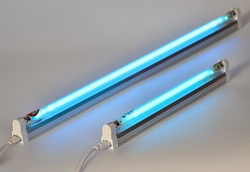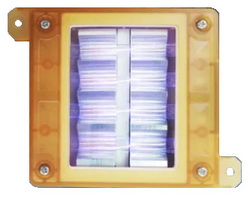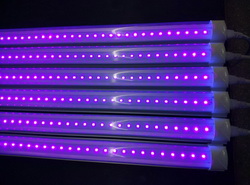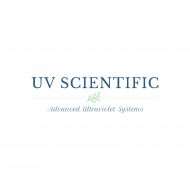Q1 : Can UVC lamps inactivate the COVID-19 coronavirus?
Ans : UVC lamps are often called “germicidal” lamps. UVC radiation has been shown to destroy the outer protein coating of the SARS-coronavirus (2003), which is a different virus from the current COVID-19 virus. The destruction ultimately leads to the inactivation of the virus. UVC radiation may also be effective in inactivating the COVID-19 virus by disrupting its DNA replication process.
Q2 : Is UVC harmful?
Ans : Direct exposure of skin and eyes to UVC radiation from some UVC lamps may cause painful eye injury and burn-like skin reactions. Never look directly at a UVC lamp source, even briefly. Some UVC lamps generate ozone. Ozone inhalation can be irritating to the airway. UVC can degrade certain materials, such as plastic, polymers, and dyed textile.
Q3 : Is UVC safe for food?
Ans : UVC will kill the gamut of microbial contaminants, whether naturally occurring or the result of bio-tampering, including Listeria, Escherichia coli, Salmonella, Staphylococcus, and other micro-organisms. UVC is SAFE to use, leaves no surface residue, and will not chemically alter food products.
Q4 : How does UVC light affect our skin?
Q5 : Are all lamps that produce UVC radiation the same?
Ans : Not all UVC lamps are the same. Lamps may emit very specific UVC wavelengths (like 254, 258 nm, or 222 nm), or they may emit a broad range of UV wavelengths. Some lamps also emit visible and infrared radiation. The wavelengths emitted by the lamp may affect the lamp’s effectiveness at inactivating a virus and may impact the health and safety risks associated with the lamp.
There is some evidence that excimer lamps, with a peak wavelength of 222-nm (Far UVC), are almost entirely absorbed by the tear layer of the eyes, and the outermost layers of human skin, which are not living cells. Therefore Far UVC with wavelength 222nm is safe for skin and eyes.
Q6 : How does the UVC light affect our eyes?
Q7 : What are the different types of lamps that can produce UVC light?
Ans :
Low-pressure mercury lamp: Historically, the most common type of lamp used to produce UVC radiation was the low-pressure mercury lamp, which has its main (>90%) emission at 254 to 258 nm. Other wavelengths are also produced by this type of lamp. There are other lamps available that emit a broad range of UV wavelengths, but also emit visible and infrared radiation.

Excimer lamp or Far-UVC lamp: Type of lamp, called an “excimer lamp”, with a peak emission of around 222 nm. On human skin, Far-UVC will be absorbed by the dead cells in the top layer of skin. In human eyes, Far-UVC will be absorbed by the outermost tear layer on the cornea.
There is some evidence that far-UVC is safe for the skin and eyes. ( See the Scientific Reports from nature.com, article “Far-UVC light 222nm efficiently and safely inactivates airborne human coronaviruses” )

LEDs: Light-emitting diodes (LEDs) that produce UV radiation are also becoming more commonly available. Typically, LEDs emit a very narrow wavelength band of radiation. Currently, available UV LEDs have peak wavelengths at 214 nm, 265 nm, and 273 nm, among others. One advantage of LEDs over low-pressure mercury lamps is that they contain no mercury. However, the small surface area and higher directionality of LEDs may make them less effective for germicidal applications.

Source :
U.S. Food & Drug Administration (FDA) official website : fda.gov
“FAQ” from uvresources.com
“UVC Safely Eliminates Bacteria” from foodqualityandsafety.com
